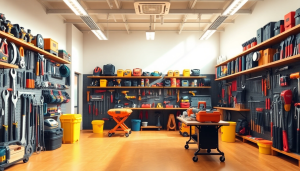Workplace Hazard Assessment for Manufacturing and More in Utah Valley

In the heart of Utah Valley, the manufacturing sector plays a pivotal role in the local economy. However, with the benefits of industrial growth come the responsibilities of ensuring a safe working environment. A comprehensive Workplace Hazard Assessment is essential for identifying potential risks and implementing effective safety measures. This article delves into the significance of Workplace Hazard Assessment in Utah Valley, particularly within the manufacturing industry, while also touching on broader environmental compliance issues.
Understanding Workplace Hazard Assessment
A Workplace Hazard Assessment is a systematic process aimed at identifying, evaluating, and mitigating risks associated with workplace activities. In Utah Valley Environmental Compliance, where manufacturing facilities are abundant, conducting these assessments is crucial for protecting employees and ensuring compliance with safety regulations. The assessment involves a thorough examination of the workplace, including machinery, materials, and processes, to pinpoint hazards that could lead to accidents or health issues.
The importance of a Workplace Hazard Assessment cannot be overstated. It serves as the foundation for developing safety protocols and training programs that safeguard workers. By identifying potential hazards, employers can take proactive measures to eliminate or control risks, thereby fostering a culture of safety within the organization.
The Role of Environmental Compliance in Utah Valley
In addition to workplace safety, environmental compliance is a significant concern for manufacturers in Utah Valley. The region is home to various industries that must adhere to local, state, and federal environmental regulations. These regulations are designed to protect the environment and public health, ensuring that manufacturing processes do not contribute to pollution or other environmental hazards.
A Workplace Hazard Assessment is closely linked to environmental compliance. By identifying hazardous materials and processes, manufacturers can implement strategies to minimize their environmental impact. This not only helps in meeting regulatory requirements but also enhances the company’s reputation as a responsible corporate citizen. In Utah Valley, where the natural landscape is a vital part of the community’s identity, maintaining environmental integrity is essential.
Key Components of a Workplace Hazard Assessment
Conducting a Workplace Hazard Assessment involves several key components. First, it requires a thorough inspection of the workplace to identify potential hazards. This includes evaluating equipment, materials, and work practices. In Utah Valley’s manufacturing sector, common hazards may include machinery-related risks, chemical exposure, and ergonomic issues.
Next, the assessment should involve employee input. Workers are often the best source of information regarding potential hazards they face daily. Engaging employees in the assessment process not only helps identify risks but also fosters a sense of ownership and responsibility for workplace safety.
Once hazards are identified, the next step is to evaluate the risks associated with each hazard. This involves determining the likelihood of an incident occurring and the potential severity of its consequences. In Utah Valley, where manufacturing processes can vary widely, this evaluation must be tailored to the specific context of each facility.

Implementing Safety Measures and Training
After completing the Workplace Hazard Assessment, the next crucial step is implementing safety measures. This may involve engineering controls, administrative changes, or personal protective equipment (PPE) to mitigate identified risks. In Utah Valley, manufacturers must prioritize these measures to ensure the safety of their workforce.
Training is another vital aspect of workplace safety. Employees must be educated about the hazards they may encounter and the safety protocols in place to protect them. Regular training sessions can reinforce safety practices and keep employees informed about any changes in procedures or regulations.
Continuous Improvement and Compliance
A Workplace Hazard Assessment is not a one-time event but an ongoing process. Regular reviews and updates are necessary to adapt to changes in the workplace, such as new equipment, processes, or regulations. In Utah Valley, manufacturers should establish a routine for conducting assessments to ensure continuous improvement in workplace safety and environmental compliance.
Moreover, staying informed about local and federal regulations is essential for maintaining compliance. Utah Valley’s manufacturing sector must be proactive in understanding and adapting to changes in environmental laws to avoid penalties and ensure the safety of both employees and the community.
Conclusion
In conclusion, a comprehensive Workplace Hazard Assessment is vital for the manufacturing industry in Utah Valley. By identifying and mitigating risks, manufacturers can create a safer work environment while also ensuring compliance with environmental regulations. The commitment to workplace safety and environmental integrity not only protects employees but also enhances the overall reputation of businesses in the region. As Utah Valley continues to grow as a manufacturing hub, prioritizing Workplace Hazard Assessment and environmental compliance will be key to sustainable success.




